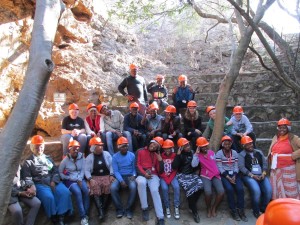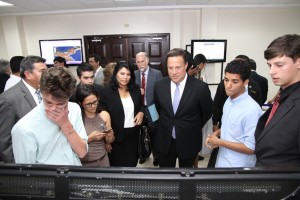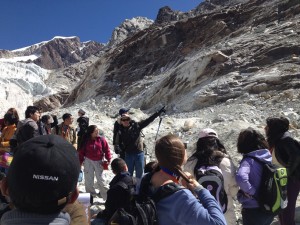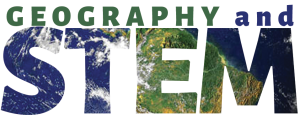You might say Quinn/Rauner was a squeaker, and Durbin/Oberweis was a cakewalk. Here’s why you’d be wrong.
The outlook was bleak nationwide for Democrats as the nation approached mid-term elections. Despite improvements in employment, troop drawdowns in Afghanistan, and increasing numbers of insured persons under the Affordable Care Act, the public’s confidence in the Obama Administration had sunk to record low levels. Most Democrats facing election contests sought to distance themselves from the very programs they had enthusiastically supported just a few years, or even months, earlier, eager to dissociate themselves from the President’s waning popularity. By the time Election Day rolled around, Democrats had resigned themselves to declining numbers in the House of Representatives with all of its two-year terms in contention; in the Senate, even their most optimistic hopes were for a 50-50 split (in which Vice President Joe Biden would be able to cast deciding votes), while more realistic expectations were that they would become at least a slim minority.
ELECTION NIGHT IN ILLINOIS SELDOM LACKS FOR DRAMA, AND THE 2014 MIDTERM ELECTION WAS NO EXCEPTION.
The Democrats best hopes were to hold on strong at the state level, among governorships and state legislatures. It was in this atmosphere that the party nervously eyed the State of Illinois, whose embattled Democratic governor Pat Quinn continued to be shadowed by the spectre of his predecessor, Rod Blagojevich, who had been ousted amidst a swirl of corruption charges. (Quinn had ascended to the governor’s chair in 2009 upon Blagojevich’s removal, and had eked out a narrow margin over Republican Bill Brady in the 2010 election.) Years of excessive capital spending and increases in public pension commitments had skyrocketed Illinois to a precarious financial position. In 2014 Quinn faced businessman Bruce Rauner, a highly-successful businessman in several private equity firms who had campaigned on the promise of restoring fiscal responsibility and integrity to the state.
Meanwhile, Senate Majority Whip Richard Durbin was considered to have a relatively safe course to re-election against dairy magnate Jim Oberweis, who was perceived by much of the electorate to be closely tied to the Tea Party and held extremely conservative views that were at odds with the extensive “blue” voter base in Illinois. Oberweis had failed twice before in attempts at statewide office, failing to progress past the primaries in a previous US Senate bid and the 2010 governor race. Finally gaining public office in the Illinois Senate, he leveraged that 2012 electoral success to position himself as the Republicans’ 2014 US Senate candidate. Durbin’s status as senior senator, his overall popularity among the electorate, and Chicago’s propensity to deliver massive Democratic margins were expected to propel Durbin to a relatively comfortable victory.
Election night in Illinois seldom lacks for drama, and the 2014 midterm election was no exception. While in the Senate race, challenger Jim Oberweis conceded to incumbent Dick Durbin just hours after the polls closed, incumbent governor Pat Quinn held fast to the possibility of victory, still declining to concede the race as of late Wednesday morning. It’s only reasonable to conclude that Durbin/Oberweis was a cakewalk, and Quinn/Rauner was a squeaker. Reasonable, but wrong – in fact, just the opposite can be argued. Application of geographic analytic tools sheds light on why this is true.
While Quinn had won only four counties in 2010, his vote margins were slim and he was carried to victory on the strength of the overwhelming margin in the perennial Democratic stronghold of Cook County. In 2014, within hours of poll closings, it was clear that this was not to be Quinn’s night – he had lost the downstate Democratic counties of St. Clair & Jackson, and his margin in Cook County was going to fall well short of his 2010 margin, and would not be nearly enough to eke out a victory for him this year.
An analytic tool called Rank-Mobility Index (RMI) helps to explain just how and where Quinn’s support fell apart. Sheer number of votes is not important in itself; rather, the vote margin between the candidates tells the story when viewed on a county-by-county basis. RMI reveals where Democratic vote production succeeded and fell short, and suggests how those changes manifested themselves in the final outcome.
To determine the RMI, the statistic of interest – in this case, vote margin for Quinn over Rauner – is computed for each county. To adjust for the effects of county size, this figure must be normalized to margin per 1000 persons of voting age (MpK). The counties are then ranked 1-102 based on their MpK for the 2010 election, and again for the 2014 election. RMI is then computed as (R2010‑R2014)/(R2010+R2014); the resulting value can range from ‑1.0 to +1.0. The power of the RMI is two-fold:
- it recognizes that large changes in rank are more significant than small changes, BUT . . .
- it also recognizes that equal changes are more significant among high ranks than among low
So, for example, in 2014, the ranks for Lake & McHenry counties were 16 and 42, respectively, while in 2010 their ranks had been 7 and 33. Both fell 9 ranks from 2010 to 2014, but Lake County’s RMI of ‑0.391 shows its shift to be more significant than McHenry’s RMI of ‑0.120.
In 2014, Cook was the only county to provide a net positive vote margin for Quinn. Thus, in Table 1, the MpK values are negative, reflecting that Quinn fell short by that number of votes for every 1000 persons of voting age. The county with the best improvement was Fulton, which in 2010 had a negative MpK of ‑35.4073; this improved to ‑6.7540 in 2014, which moved Fulton County up from 8th‑best to 2nd‑best in producing a Democratic margin. Franklin County, on the other hand, declined from ‑21.3725 MpK to ‑117.1895 MpK, dropping it from 6th-best to 43rd-best and resulting in a large negative RMI.
Charting the RMIs on the map thus provides insight into details of Quinn’s performance. The blue counties, denoting improvement in Democratic vote production, form a swath from northwest to east-central Illinois, taking in primarily rural counties with lower voter counts. Meanwhile, Cook County shows a decline in performance (while retaining the number 1 rank, its MpK fell from 126.3259 in 2010 to 98.1427 in 2014), as do the collar counties and southern counties. Significantly, the key downstate counties of St. Clair, Jackson, and Alexander all showed rather strong decreases in Democratic voter production, and indeed all turned from blue to red in the 2014 election.
Turning to the U.S. Senate race, the differences between the 2008 margins and 2014 margins are much more dramatic than the 2010-2014 changes in the governor’s race. As usual, Cook County Democrats turned out in numbers sufficient to offset downstate Republicans and tip the balance to Durbin. But the breadth and depth of the Republican margins, especially when compared to the almost-all-blue map of 2010, is certainly an attention getter. Once again, RMI helps to reveal the story within the story.
The strongest gains in Democratic vote production were in three far-southern counties – Jackson, Alexander, and Pulaski, two of which had already demonstrated a strong Democratic margin in both the 2008 Senate race and the 2010 governor’s race. Central Illinois, from Bureau & LaSalle counties in the north to Effingham & Jasper counties in the south, demonstrated a solid Republican upswing, especially in Putnam, Mason, and Macon counties. Those changes in relatively low population counties may not have been, by themselves, significant – until Democratic bastion Cook County is considered. The effectiveness of Democratic vote production in Cook actually declined relative to the other counties in the state – making it all the more important for Durbin to put in a strong showing downstate. Of the top five counties in voter production in 2008, however, three – Putnam, Gallatin, and Mason – fell to the bottom five in 2014. Lake County, recently more evenly split between the parties than most of the other collar counties, edged into the top five RMI by moving from 27th rank to 11th, but that was primarily by virtue of even worse performance by other counties, as Lake’s MpK fell from 172.8010 to 7.5804.
One last key question is this: How did the candidate perform compared to other candidates of the same party? In particular, with major statewide offices such as Governor and U.S. Senator, did one race either help or hinder the other? Using RMI to compare Democratic vote production for the governor’s race vs. the U.S. Senate race suggests that Durbin, while mostly coasting toward a fairly comfortable victory, may well have been hampered by Quinn’s unpopularity. Those counties showing improved vote production for Senate vis-à-vis all other counties are mainly clustered in the far downstate region of the state. Meanwhile, the populous counties of the north, and particularly the northeast, demonstrated a strong decline in effectiveness in vote production, Lake County being the only significant exception. Perhaps Democrats came out in stronger numbers for Quinn in light of his anticipated contest, while showing disinterest in Durbin’s expected easy cruise to victory.
The only numbers that ultimately matter, of course, are the final statewide vote tallies. But putting the power of the RMI to use helps to show that there’s a lot more to the story than revealed by the raw numbers.
Acknowledgement to Dr. Richard Greene, Department of Geography, Northern Illinois University, for contributions to the methodology included in this analysis.
James W. Newman
Department of Geography
Northern Illinois University
DOI: 10.14433/2014.0022




